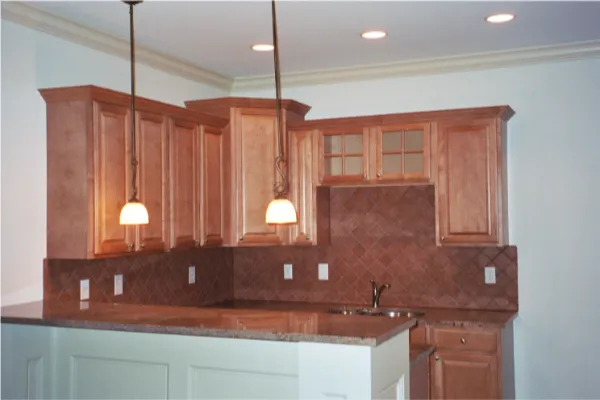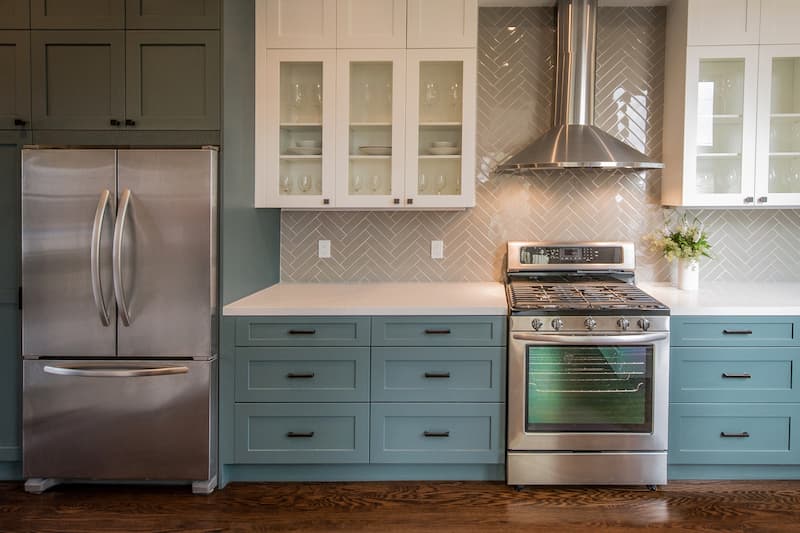The cost of remodeling or renovating a kitchen can vary. A beautiful and useful kitchen backsplash won’t break the bank, either.
One question we hear a lot during our design consultations is, “Where should my kitchen backsplash start and stop?” The answer is based on many factors, including your house, style, finances, and more.
Here are some placement recommendations for backsplashes to aid in your decision.
Table of Contents
Basic Guidelines for Kitchen Backsplash Placement
Your kitchen backsplash’s beginning and ending points are influenced by a variety of factors. There might be an obvious row of upper and lower cabinets that require a backsplash in between. For less obvious circumstances though, here are some guidelines:
- Put a backsplash where food preparation will take place. The primary goal of a backsplash is to facilitate simple cleanup. In the kitchen, place your backsplash next to the areas where you prepare food.
- Place your kitchen backsplash between the upper and lower cabinets.Because the backsplash links the two sets of cabinets, the space appears larger and more cohesive.
- Put a backsplash there only if you can see the wall behind your refrigerator.The area behind the refrigerator is typically hidden from view in the entire kitchen. There is no need to spend money on labor and materials for a location you won’t visit.
- A backsplash should be installed behind your cooktop and hood vent.To add visual interest to the kitchen, many homeowners will install accent tile behind the cooktop and hood vent. Cleaning up the mess left by your stove’s grease, bubbling sauce, steam, and other substances is difficult. There will be no headache if there is a backsplash there.
- To indicate the end of your backsplash, use your cabinets. Although the backsplash could be continued past the cabinets, this marks a logical end to the backsplash.

Tips for Kitchen Backsplash Placement
Where your kitchen backsplash begins and ends is affected by a number of different factors. The closest to the area of food preparation is the ideal starting point for a peel and stick wall tile. Because peel and stick wall tiles are simple to clean, this is one of their main advantages.
Your kitchen will appear larger if a peel-and-stick backsplash is placed between upper cabinets and counters. If the fridge is not going to be visible in the kitchen, there is no need to install a peel-and-stick backsplash behind it. The end of your cabinets is the ideal location to finish a peel and stick backsplash.
Should I Run My Backsplash to the Ceiling?
Your personal preference should be respected regarding the height of your kitchen backsplash. Many homeowners stop their backsplashes at the base of their upper cabinets. Some individuals, though, opt to tile the ceiling all the way up. By directing the gaze upward, this may give the impression that the kitchen is taller. Depending on the backsplash style you choose, it can also draw attention to open shelves and other features. For a more “high end” appearance, run the backsplash all the way to the ceiling.
Cost Saving Tips
- You may not be able to afford a countertop to ceiling tile. However, you can choose a PVC or faux tin backsplash, which costs a few dollars less per square foot than premium tiles, for a sophisticated look and to maintain functionality.
- When finishing a backsplash around a window, tile downward in a color that complements the wall rather than upward. If your walls are white, you can select cream tiles to match their color. With a glamorous kitchen, you can use fewer square feet of tiles.
- Select a countertop design that goes well with your backsplash. The backsplash should be the same color as the countertop because doing so is simpler, more cost-effective, and easier from an aesthetic standpoint. Choose a granite countertop if your desired backsplash is 4 inches thick.
- Fill in kitchen backsplash gaps with peel and stick tiles that are ideal for easy renovations. Compared to painting, the tiles are more affordable and produce a better appearance.
- Tile the kitchen fridge’s back wall only if you can see it. Instead, cover the area behind the stove with the tiles to shield your wall from steam. If you want to cover the stove, use a tile with a striking color.
- To preserve the natural appearance and safeguard the grout from stains, seal the tiling with a clear polyurethane sealer.
FAQs
Where Do You Start Backsplash in Kitchen?
One thing to remember: never start your tile backsplash at the end. Because all of your smaller cuts will be concentrated in one area, the project will look uneven and sloppy. By starting in the center of a wall or a focal point, you will be able to better manage tile placement for a cleaner and more professional look.
Do You Start Backsplash Countertop?
In most cases, installing the countertops before the backsplash makes the most sense. However, depending on your specific situation, it might make more sense to install the backsplash first before the countertop. What you want to be the center of attention in your kitchen will determine the rest.
Final Words
Where your kitchen backsplash should end is not something that can be determined with absolute certainty. Although you can certainly experiment with the limits of your backsplash design, it is best to keep it within the cabinet lines’ visual range. We have provided you with suggestions for the best backsplash finishing points. Despite the variations among kitchens, you can use our advice to solve any backsplash-related puzzle. You will be fine if you don’t tile the extra sidewalls.
Considering that you will be seeing the backsplash every day, pick a color you like. Always look for areas of natural transition to end the backsplash.


